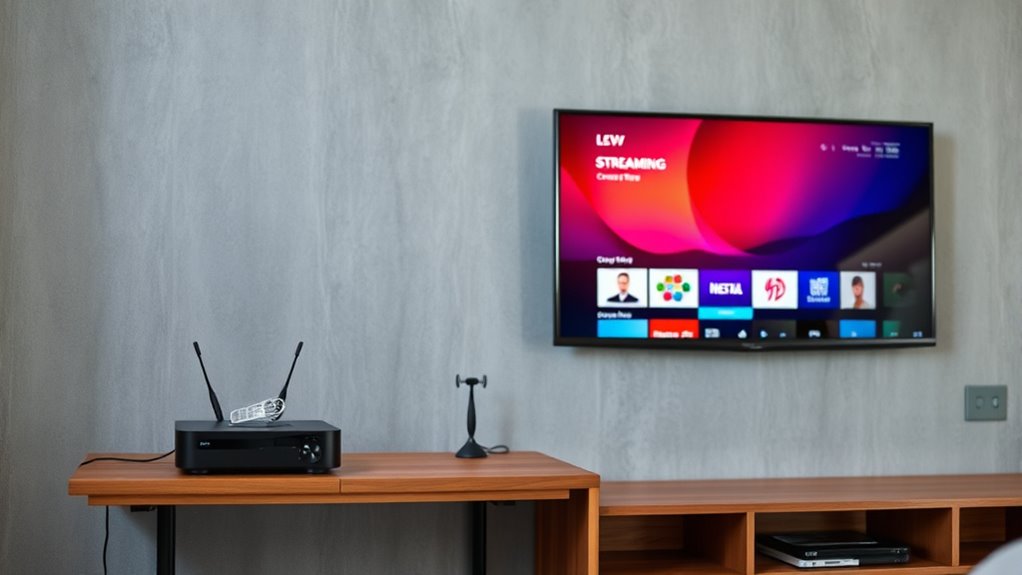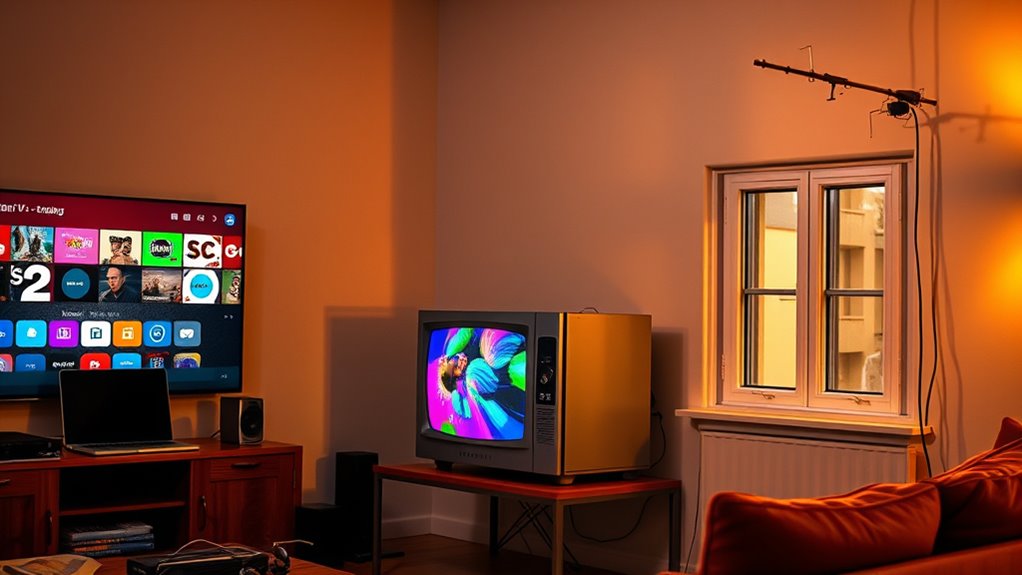If you want the cheapest way to watch TV, an antenna is your best bet since it’s free and gives access to major networks like ABC, CBS, NBC, and FOX. Streaming services are more affordable than cable but still cost $45 or more monthly and may limit local channels. Cable offers the widest selection and reliable quality but is the most expensive, often over $80 a month. To find out which option fits your needs best, keep exploring your options.
Key Takeaways
- Antennas are the cheapest option with no monthly fees, providing free access to major networks.
- Streaming services are more affordable than cable but often require additional fees for sports and premium channels.
- Cable offers the widest channel selection and reliable service but at a higher monthly cost compared to antenna and streaming.
- Streaming provides flexibility with on-demand content but can become expensive with added channel packages and sports.
- The best cost-effective choice depends on your channel needs, with antennas for basic local channels and streaming for more variety.

When choosing how to watch TV, understanding the differences between streaming services, cable, and antennas can help you make an informed decision. If you’re looking for the cheapest way to access local channels and premium sports, it’s crucial to weigh the costs and coverage each option offers. Antennas are the most budget-friendly for local channels, offering free access to major networks like ABC, CBS, NBC, and FOX with a one-time hardware purchase. You won’t pay any monthly fees, making antennas ideal if local programming is your priority. However, they don’t provide cable or streaming-only channels, nor do they support premium sports or on-demand features.
Streaming services vary widely in price, typically ranging from about $45 to over $170 per month, depending on the package and provider. Cheaper options like Sling TV start around $45, offering a decent selection of channels, including some local affiliates via ZIP code validation. But if you want premium sports channels—covering leagues like NBA, NFL, NHL, MLB, and regional sports networks—you’ll need to opt for more extensive plans. For example, DIRECTV Stream’s higher-tier packages include 30+ sports channels, giving you extensive sports coverage, but these can cost $90 or more monthly plus additional add-ons. While streaming services offer a broad channel lineup, their prices are rising, and some platforms have limited local channel access, which can be a drawback if local news and events matter to you.
Cable TV generally provides the widest channel selection, often exceeding 150 channels, including local channels, premium movie channels, and regional sports networks. Its cost tends to be higher, frequently over $80 per month, but it delivers reliable coverage of both local broadcasts and premium sports, often bundled with DVR and other features. If sports are a major focus, cable’s extensive packages usually include comprehensive regional sports coverage without additional expense, unlike streaming services that charge extra for premium sports channels. Cable providers also often bundle internet and phone services, which can lead to cost savings and added convenience. The reliability and consistency of cable signals make it a preferred choice for many viewers seeking dependable service.
Most streaming services come with DVR options, with top providers like Hulu + Live TV and YouTube TV offering unlimited DVR storage, which is a significant advantage for recording live sports and shows. Sling TV limits DVR to 50 hours unless you pay more, while cable providers often include DVR with varying storage capacities. Antennas don’t support DVR unless paired with external hardware, which adds complexity and cost. Overall, if minimizing costs and access to local channels are your priorities, antennas are the cheapest. But if you want a mix of local channels, premium sports, and on-demand features, streaming offers flexibility—though at a higher price. Understanding the differences in channel coverage and features] can help you choose the best option for your needs.
Frequently Asked Questions
Can I Combine Streaming, Cable, and Antenna for Better Coverage?
You can definitely combine streaming, cable, and antenna for better coverage. Using multi platform bundles, you get access to more channels, including local broadcast stations with the antenna. This setup improves signal reliability, especially when internet issues disrupt streaming. By blending these options, you enjoy a mix of live TV, on-demand content, and free local channels, giving you a flexible, all-encompassing viewing experience tailored to your needs.
How Does Internet Speed Affect Streaming Quality?
Your internet speed directly impacts your streaming quality by affecting bandwidth requirements and causing internet buffering. When your connection is slow or unstable, videos buffer more often, pixelate, or drop quality. To enjoy smooth streaming, you need enough bandwidth to meet the demands of higher resolution videos, like 4K. Ensuring consistent, high-speed internet helps prevent buffering and provides better picture clarity, making your viewing experience much more enjoyable.
Are There Any Hidden Costs With Streaming Services?
Imagine you sign up for a streaming service, only to discover hidden costs later. You might face rising subscription fees, unexpected device costs if you buy new gadgets, or extra charges for premium add-ons. These hidden expenses can sneak up on you, making streaming more expensive than you thought. Always check for additional fees beyond the base price to avoid surprises and keep your budget under control.
Which Option Offers the Best Sports Channel Access?
You want the best sports channel access, and sports packages vary greatly. Streaming services like Fubo and Hulu + Live TV offer extensive channel access, including regional sports networks and major league coverage. Cable TV provides the widest sports packages, especially for local RSNs and national channels. Antennas can’t access subscription channels but give free access to major broadcast sports. Choose based on your preferred sports and budget for ideal channel access.
How Do Local Channels Vary Between Cable and Antenna?
Imagine flipping through your channels—on cable, local stations come from regional differences in programming, but their signal reliability can vary with congestion or weather. With an antenna, you get a direct broadcast, often offering clearer, uncompressed signals and access to additional sub-channels. Your experience depends on your location, as antenna signals can weaken with distance and terrain, while cable offers consistent local channel access regardless of regional differences.
Conclusion
So, after all this, maybe the cheapest way to watch TV isn’t about saving money at all. You might find yourself paying for multiple streaming services, upgrading antennas, or sticking with costly cable just to keep your favorite shows. Ironically, the simplest option—an old-fashioned antenna—may be your best bet. Sometimes, going back to basics proves that the best choice isn’t always the most high-tech or expensive, but the one you overlook the most.










